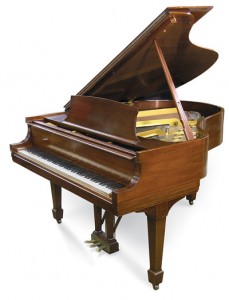 To begin, it is important to understand that no two Steinway pianos are alike. As individuals, we each have special characteristics that appeal to others. Each Steinway has its special Characteristics too. Since 1853, Steinway & Sons has hand-crafted every piano to bring out it’s individuality. The question that you should focus on is which one meets your particular expectations, needs and personality. Let’s walk through the 4 S’s of Selecting a Steinway piano.
To begin, it is important to understand that no two Steinway pianos are alike. As individuals, we each have special characteristics that appeal to others. Each Steinway has its special Characteristics too. Since 1853, Steinway & Sons has hand-crafted every piano to bring out it’s individuality. The question that you should focus on is which one meets your particular expectations, needs and personality. Let’s walk through the 4 S’s of Selecting a Steinway piano.
Consider the following attributes, which can be described as the 4 S’s:
Style – Consider the style and felling you want to convey in the room in which you will place the piano. If the room is designed in a specific period style, you may want to search for a design to match the setting. You always have the option to go with the timeless tradition look, the classic ebony spade leg. For a look that conveys a professional, understated elegance, and ebony piano finish is a good choice.
Size – Of course, one must consider the size of the Steinway. A 9ft Concert Grand in a 15’x15′ room is as out of place as a 45″ vertical piano on the stage of Carnegie Hall. A good general rule is that if you will be selecting a piano for its tonal quality and harmonic richness, you will want to get the largest instrument possible for the room. Since every room is acoustically different, it is hard to establish a rule of thumb for everyone. However, in an effort to simplify matters, it is generally best if a room is at least four times the size of the instrument. When trying to plan your room and visualize the piano in it check with you local Steinway dealer who can provide you a grand piano template to lay on the floor to help visualize the different sizes available.
Sound – To a player, this is paramount. The importance of the sound of the instrument is first and foremost. The sound of the Steinway piano can be categorized in many areas. Some break it down into clarity, richness, level of brilliance, depth and even loudness. The soul of the piano is what you hear and feel after the initial impact of the hammer. Some pianos will sound warm, some shallow and others will sound deep. The quality of the piano is dependent on the sum of the parts of the piano, in particular, the woods. Even though every Steinway uses the same quality and species of structural wood for every piano, the sounds are different because the woods vary. Remember, no two trees are alike, just as no two people are alike. The most important thing to remember is that YOU are the final decision-maker here. There is no good or bad sound. There is only the sound that you prefer.
Sensation – The term sensation pertains to the touch or feel of the keys. This is another important area of concern for pianists. One the tone (sound) is selected, the touch is next in line. All Steinway pianos have an action designed to allow the performer the greatest control over the tone of the piano. The weight of the keys can be described as the amount of energy that one must exert to get the key moving. *Interesting Fact* Today, through Steinways close relationship with the concert artist community they have developed a lighter action than those used years ago. As a general rule of thumb it is best to select a key weight and resistance (touch/sensation) that will afford you control of the keyboard comfortably. As in the step before this you are the best judge of what feels best to you.
Sum it up with the 4 S’s. When selecting a Steinway, keep in mind the “Four S’s of Selection,” Style, Size, Sound and Sensation. These will be extremely helpful in leading you to the right piano for your needs.
Tips
- Play as many Steinway piano as possible.
- When selecting a Steinway take notes. Ask for a pen and pad. Write down each serial number and make notes about what you liked or didn’t like about that piano.
- After you narrow your selection down to three, take a break. Then come back with fresh ears and hands and play them again.
- Ask others to play, so you can stand back and listen to the piano from various distances and angles. Close your eyes and ask yourself which one sounds the best.
- Have fun. You are about to select a piano that 98% of performing concert artists choose to perform on.
